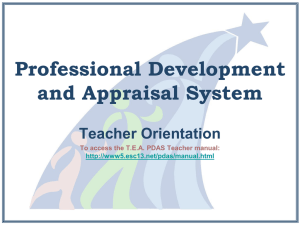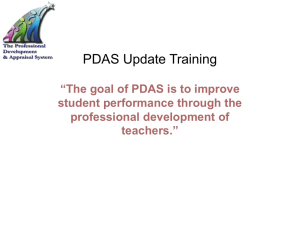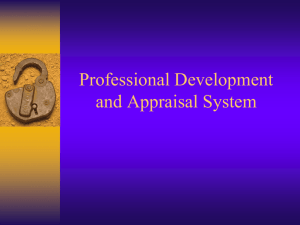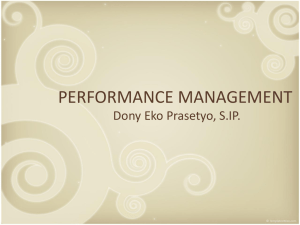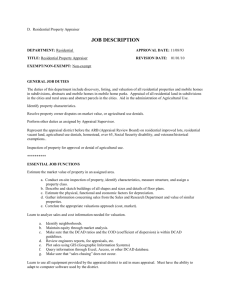Professional Development and Appraisal System
advertisement
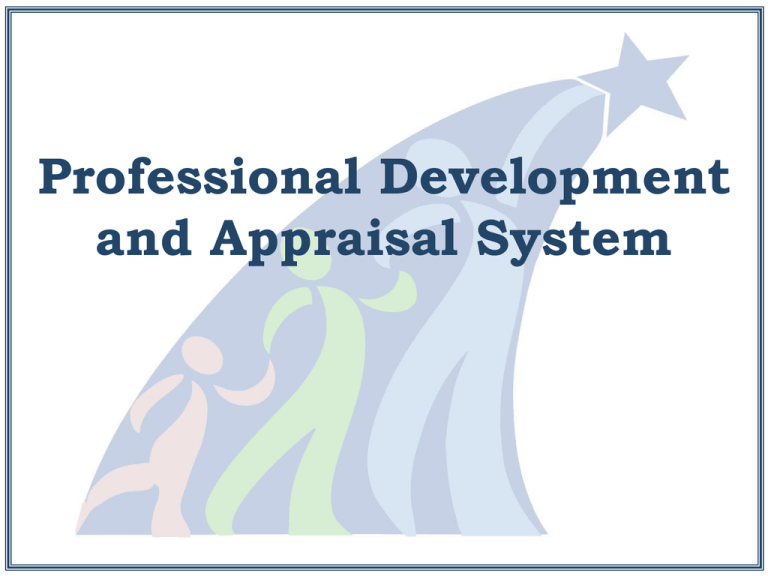
Professional Development and Appraisal System PDAS Teacher Orientation ► A school district shall ensure that all teachers are provided with an orientation of the Professional Development and Appraisal System (PDAS) no later than the final day of the first three weeks of school and at least three weeks before the first observation. 2 Overview of the System This presentation provides an overview of the elements of the PDAS system and its goal: “…to improve student performance through the professional development of teachers.” Chapter 1 3 PDAS Characteristics ► Learner Centered ► Aligned ► High Standard of Proficiency ► Teacher Growth and Teacher Improvement ► Collaboration 4 Expected Observations • • • • • • Researched-based instruction Students thoroughly engaged Technology integration Teachers actively participating High levels of thought Students using new learning to create and solve • Classroom atmosphere that is conducive to learning 5 Appraisal Process Steps ► Teacher Orientation ► Teacher Self Report (TSR) ► Formal Classroom Observation ► Walkthroughs ► Student Performance as demonstrated by the data ► Summative Annual Report/Conference 6 APPRAISAL PERIOD TIME LINE SCHOOL CALENDAR YEAR First 12 Weeks Teacher Orientation • Within 1st 3 weeks • Observations no earlier than 3 weeks after this orientation Teacher Self Report, Part I • No later than three weeks after orientation Second 12 Weeks Teacher Self Report II & III At least two weeks prior to Summative Conference Third 12 Weeks Last 15 Days of INST. Self-Reports II & III due by April 14, 2014 Teacher Self-Report I due by September 13, 2013 in DMAC Formal Observation • Minimum of 45 minutes or shorter segments Formal Observations will begin October 1, 2013 • Written summary within 10 working days During a two week window. • Advanced notice may be given/NOT REQUIRED. • Follow district APPRAISAL CALENDAR • May have pre- or post-conference at request of Teacher or Appraiser. WALKTHROUGH VISITS • To be used at the discretion of the appraiser • Documentation shared with teacher within 10 days ADDITIONAL TIME LINE ISSUES Teacher Response • Within 10 working days (Appraiser may extend to 15) • May rebut in writing or request 2nd appraisal within 10 working days after receiving the OSF or Summative Annual Appraisal Report Plan on regular walk-through evaluations and drive-by observations. Feedback will provided through DMAC. SUMMATIVE ANNUAL REPORT • 5 working days before conference • No later than 15 working days before last day of instruction • Observation Summary All teachers will have a • Walkthrough documentation summative conference. • Third party/Teacher documentation • Completed TSR SUMMATIVE CONFERENCE • No later than 15 working days before last day of instruction • If Appraiser is not administrator on campus, principal/asst. or designated supervisory staff will participate. 7 Continuous Improvement Process There is an expectation that all teachers will be continually changing and evolving through reflective research and evaluation of their teaching methods and results. Needs Assessment • Data collection • Analysis Summative Evaluation Goals & Objectives Quality Ongoing Formative Evaluation Strategies & Activities Student Performance Professional Development & Sustained Support Implementation • Who? • What? • What do we need? 8 Teacher Self Report (TSR) Primary Documentation Tool The Teacher Self Report: ► Gives you an opportunity to have input into your appraisal process. ► Serves as a platform to align instruction. ► Is a reflective tool. Chapter 6 9 Classroom Observation ► The formal observation will take place according to your district’s guidelines and is a minimum of 45 minutes. ► Walkthroughs can take place any time during the year and may be any length the appraiser feels is necessary. ► You can expect no less than two walkthrough’s per six weeks period. 10 Scoring Factors and Performance Level Indicators ► Critical Attributes ► Quality of the lesson ► Quantity – In what percentage of the lesson can the critical attributes be observed? 11 Critical Attributes • Domain I – Quantity and Quality of active student participation in learning process • Domain II – Learner-Centered instruction, including appropriate goals and objectives, research based strategies, high level thinking, student engagement • Domain III – Assessment of student progress toward meeting the objective being taught – How do you know they got it? 12 Critical Attributes, cont. • Domain IV – Student and classroom management. Efficient and effective use of class time involving all students. • Domain V – Professional Communication – Do you communicate effectively and positively with students, parents, coworkers, community members? Do you represent our school well? 13 Critical Attributes, cont… • Domain VI – Professional Development – Are you constantly looking for ways to improve your teaching. Prof. Dev., research, innovation, collaboration, etc. • Domain VII – Compliance with directives, policies, rules, etc. How committed are you to taking an active role in making our school safe and excellent? • Domain VIII – How effective is your work toward improving student performance? 14 Quality Scoring Standards • S trength • I mpact • V ariety • A lignment 15 • Exceeds Expectations – Consistently shows great evidence of SIVA • Proficient – Shows considerable evidence of SIVA • Below Expectations – Occasionally shows evidence of SIVA • Unsatisfactory – Rarely/never shows evidence of SIVA • SIVA – Strength, Impact, Variety, Alignment 16 Strength • • • • Thinking at high cognitive levels Depth & Complexity Significant Content Connecting within/across disciplines & work/life applications • Effective, clear & substantive 17 Impact • • • • • • Promotes student success Effective use of assessments Data-driven decision making Responsibility Reflection Challenging 18 Variety • Varied student characteristics • Differentiated instruction • Support strategies & services 19 Alignment • Curriculum, instruction and assessment aligned with TEKS & district objectives • Targeted instruction • Congruent 20 Quantity ► Can you see it? ► Did it happen? ► How often? ► How many students? 21 • Exceeds Expectations – All or almost all the time – observed 90-100% of the time. • Proficient – Most of the time – Observed 8089% of the time. • Below Expectations – Some – Observed 5079% of the time. • Unsatisfactory – Less than half the time. 22 Quantity – Repeated Evidence • Exceeds Expectations – from beginning to end, routines are seamless, consistently present, predictable • Proficient – common practice, typical, as a general rule • Below Expectations – sporadic, random, irregular, some • Unsatisfactory – infrequent, nonexistent, minimal 23 Target Evaluation -The target for PDAS evaluations is “Proficient” -In order to receive an “Exceeds Expectations”, the critical attributes must be evident 90-100% of the time. Chapter 7 24 Teacher Self Report Parts II and III ► Parts II and III of the TSR give you an opportunity to give your appraiser additional information about your efforts to improve your students’ performance. ► This should change from year to year through reflection – not copied and pasted from last year. Chapter 8 25 Summative Annual Conference ► Your summative annual conference will occur within the required timeline. ► It is your opportunity to get and give feedback on the year. ► Summatives will be positive and productive – expect 10-15 minutes for each conference. *from §150.1003. Appraisals, Data Sources, and Conferences of the Commissioner’s Rules Chapter 9 26 Professional Development and Appraisal System Remember, “The goal of PDAS is to improve student performance through the professional development of teachers.” 27
